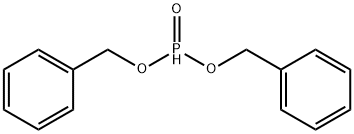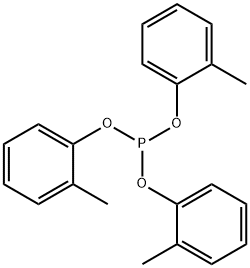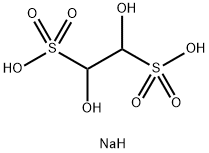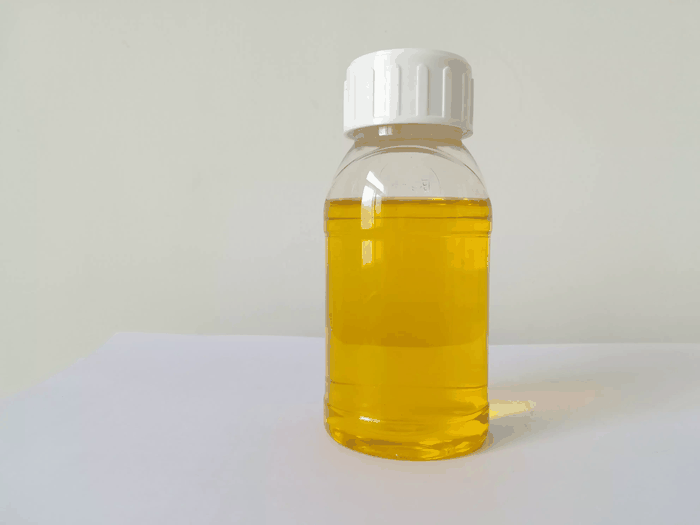Dibenzyl phosphite
Synonym(s):Dibenzyl phosphonate
- CAS NO.:17176-77-1
- Empirical Formula: C14H15O3P
- Molecular Weight: 262.24
- MDL number: MFCD00004774
- EINECS: 241-226-1
- SAFETY DATA SHEET (SDS)
- Update Date: 2025-07-24 18:13:40

What is Dibenzyl phosphite?
Chemical properties
Clear colorless to yellow liquid
The Uses of Dibenzyl phosphite
Dibenzyl Phosphite is used in the preparation of phenylalkylphosphonamidates which are then used as probes for a hydrophobic binding register in prostate-specific membrane antigen.
The Uses of Dibenzyl phosphite
In preparation of N-phosphorylated amines.
The Uses of Dibenzyl phosphite
Dibenzyl phosphite is used for the phosphorylation of phenols involves reaction in the presence of N-ethyldiisopropylamine and DMAP to give the dibenzyl phenyl phosphate. It is used in the preparation of phenylalkylphosphonamidates which are then used as probes for a hydrophobic binding register in prostate-specific membrane antigen.
Properties of Dibenzyl phosphite
| Melting point: | 0 to 5° |
| Boiling point: | 110-120 °C/0.01 mmHg (lit.) |
| Density | 1.187 g/mL at 25 °C (lit.) |
| refractive index | n |
| Flash point: | >230 °F |
| storage temp. | 2-8°C |
| solubility | Chloroform (Slightly), DMSO (Slightly), Methanol (Slightly) |
| form | Liquid |
| color | Clear colorless to yellow |
| Water Solubility | Soluble in DMSO, Methanol. Reacts with water. |
| Sensitive | Air & Moisture Sensitive |
| Merck | 14,3014 |
| BRN | 1982794 |
| CAS DataBase Reference | 17176-77-1(CAS DataBase Reference) |
| NIST Chemistry Reference | Dibenzyl phosphite(17176-77-1) |
Safety information for Dibenzyl phosphite
| Signal word | Warning |
| Pictogram(s) |
 Exclamation Mark Irritant GHS07 |
| GHS Hazard Statements |
H315:Skin corrosion/irritation H319:Serious eye damage/eye irritation H335:Specific target organ toxicity, single exposure;Respiratory tract irritation |
| Precautionary Statement Codes |
P261:Avoid breathing dust/fume/gas/mist/vapours/spray. P264:Wash hands thoroughly after handling. P264:Wash skin thouroughly after handling. P271:Use only outdoors or in a well-ventilated area. P280:Wear protective gloves/protective clothing/eye protection/face protection. P302+P352:IF ON SKIN: wash with plenty of soap and water. P305+P351+P338:IF IN EYES: Rinse cautiously with water for several minutes. Remove contact lenses, if present and easy to do. Continuerinsing. |
Computed Descriptors for Dibenzyl phosphite
| InChIKey | DYUGVWSETOTNKQ-UHFFFAOYSA-N |
Dibenzyl phosphite manufacturer
New Products
Indole Methyl Resin tert-butyl 9-methoxy-3-azaspiro[5.5]undecane-3-carboxylate Boc-His(Boc)-OH 2-CTC Resin 4-Chloro-7-tosy1-7Hpyrrolo[2,3-d]pyrimidine 5,7-Dibromo-1H-indole 2,5-dichloro-N-hydroxy-4,6-dimethylpyridine-3-carboximidamide 2,2-Dimethoxy-7-azaspiro[3.5]nonane hydrochloride 4-chloromethyl-5-methyl-1,3-dioxol-2-one (DMDO-Cl) R-2-BENZYLOXY PROPIONIC ACID 1,1’-CARBONYLDIIMIDAZOLE 1,1’-CARBONYLDI (1,2-4 TRIAZOLE) N-METHYL INDAZOLE-3-CARBOXYLIC ACID 4-((2-hydroxyethyl)thio)benzoic acid 1-(TERT-BUTOXYCARBONYL)-2-PYRROLIDINONE Methyl 6-methylnicotinate 3-Pyridineacrylic acid tert-Butyl carbazate TETRAHYDRO-2H-PYRAN-3-OL 2-((4-morpholinophenylamino) (methylthio) methylene) malononitrile 3-(4-morpholinophenylamino)-5-amino-1H-pyrazole-4-carbonitrile 2,4-dihydroxybenzaldehyde 1,3-Diethyl-1,3-Diphenylurea Methyl 2-methylquinoline-6-carboxylateRelated products of tetrahydrofuran








You may like
-
 17176-77-1 Dibenzyl phosphite 99%View Details
17176-77-1 Dibenzyl phosphite 99%View Details
17176-77-1 -
 Dibenzyl phosphite 90% CAS 17176-77-1View Details
Dibenzyl phosphite 90% CAS 17176-77-1View Details
17176-77-1 -
 Dibenzyl Phosphite CAS 17176-77-1View Details
Dibenzyl Phosphite CAS 17176-77-1View Details
17176-77-1 -
 Dibenzyl phosphite CAS 17176-77-1View Details
Dibenzyl phosphite CAS 17176-77-1View Details
17176-77-1 -
 Dibenzyl phosphite CAS 17176-77-1View Details
Dibenzyl phosphite CAS 17176-77-1View Details
17176-77-1 -
 Pyridine 99.5% HPLC /UV SpectroscopyView Details
Pyridine 99.5% HPLC /UV SpectroscopyView Details
110-86-1 -
 Dibutyl PhthalateView Details
Dibutyl PhthalateView Details
84-74-2 -
 Thiourea 99% ARView Details
Thiourea 99% ARView Details
62-56-6
Statement: All products displayed on this website are only used for non medical purposes such as industrial applications or scientific research, and cannot be used for clinical diagnosis or treatment of humans or animals. They are not medicinal or edible.
